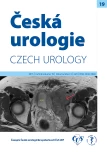PHOTOSELECTIVE VAPORISATION OF THE PROSTATE (PVP) COMBINED WITH LAPAROSCOPIC URINARY BLADDER DIVERTICULECTOMY
Authors:
Milan Hora 1; Viktor Eret 1; Petr Stránský 1; Ivan Trávníček 1; Olga Dolejšová 1; Kristýna Kalusová 1; Tomáš Pitra 1; Zdeněk Chudáček 2; Ondřej Hes 3
Authors‘ workplace:
Urologická klinika, LF UK a FN Plzeň
1; Radiodiagnostické oddělení, LF UK a FN Plzeň
2; Šiklův ústav patologie, LF UK a FN Plzeň
3
Published in:
Ces Urol 2015; 19(3): 185-187
Category:
Video
Overview
Introduction:
Pseudodiverticulum of urinary bladder is usually associated with Bladder Outlet Obstruction (BOO). Trdaditionally the most common surgical management was open prostatectomy with diverticulectomy (D). More recently, two-stage endoscopic procedures have been usedFirstly, TURP,followed by laparoscopic diverticulectomy (LD). We present the option of a single operation using green laser photoselective vaporization of the prostate (PVP) and LD.
Material:
From 1/2011 to 7/2015, 18 LDs were performed. The mean age was 62.4±10.0 (36.0 to 75.1). The size of diverticulum was 62.2±22.5 (26–120) mm. In three cases only the diverticulum was treated, twice with laparoscopic radical prostatectomy and 13x combined with BPH treatment. In 4 cases TURP was performed before LD. In 9 cases LD was combined simultaneously with PVP. As a part of the preoperative examination 3D CT cystography or better CT IVU (for better imagining of the relationship between ureters and diverticulum) were used.
Results:
9 men, aged 67 0±5 1 (57 3 to 75 1) years BMI 28 3±4 1 (23 0 to 35 0) Prostate volume measured by transabdominal sonography was 43 4±14 2 (30–80) ml PSA 2 7±1 8 (0 5 to 6 5) ng/ml The procedure was carried out under general anaesthesia in endoscopic (lithotomy) position. No routine antibiotic prophylaxis PVP was performed, in the fi rst case by Green Light Laser® HPS and 7x by XPS Green Light Laser (cooled MOXY® fibre) Delivered energy by PVP was 191 6±107 3 (84–458) kJ. At the end of endoscopy stenting of the ureter on the side of the diverticulum (or both ureters according to localization the diverticulum) was performed. The patient was re‑positioned to Trendelenburg Laparoscopic diverticulectomy was performed using 4 ports (2x5 and 2x10 mm) by extravesical transperineal approach The size of the diverticulum was 61 5±19 8 (26–90) mm. The mean time of operation was 166 5±44 7 (90–255) Ureteral catheter was removed fi rst day after surgery, bladder catheter the sixth postoperative day. No postoperative complications were observed. The first patient underwent TUR incision for sclerosis of bladder neck after one year.
Conclusion:
Resolution of subvesical obstruction with urinary bladder diverticulectomy is not a common procedure in daily practice The combination of PVP and LD is a modern minimally invasive method. We currently intend to give it a clear preference in clinical practice to the other methods It is only isadvantageous from the point of financing using our DRG system, which is more profitable with a two stage procedure.
Key words:
Urinary bladder diverticulum, laparoscopy, BPH, photoselective vaporization, green light laser.
Labels
Paediatric urologist Nephrology UrologyArticle was published in
Czech Urology

2015 Issue 3
Most read in this issue
- URACHAL ANOMALIES – A RARE CAUSE OF ABDOMINAL PAIN AND FEVER
- EXTRA-ANATOMIC STENTS AS AN ALTERNATIVE OF NEPHROSTOMY
- IATROGENIC URETERAL LESION DIAGNOSED AFTER ONE MONTH
- LAPAROSCOPIC RADICAL CYSTECTOMY – FIRST EXPERIENCE
